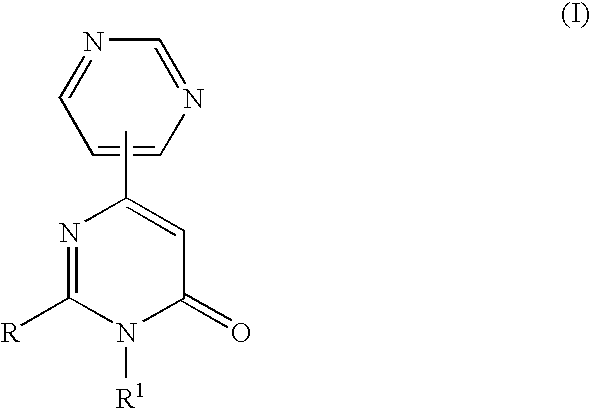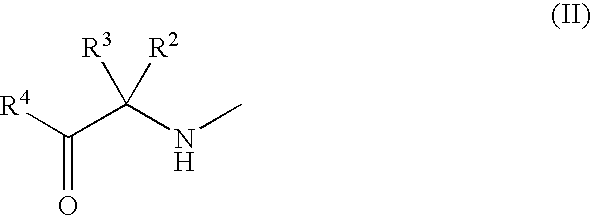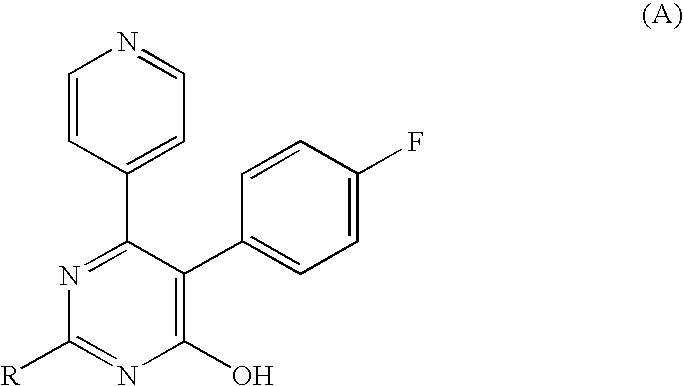3-Substituted-4-pyrimidone derivatives
- Summary
- Abstract
- Description
- Claims
- Application Information
AI Technical Summary
Benefits of technology
Problems solved by technology
Method used
Image
Examples
example 1
Synthesis of 2-mercapto-3-methyl-6-pyrimidin-4-yl-3H-pyrimidin-4-one
[0197] A solution of ethyl 3-oxo-3-(4-pyrimidyl)propionate (34.1 g, 176 mmol), N-methylthiourea (47.5 g, 527 mmol) and 1,8-diazabicyclo[5,4,01-7-undecene (26.3 ml, 176 mmol) in ethanol(340 ml) was refluxed for 2 hours and the solution of methanesulfonic acid (16.9 g, 176 mmol) in water (70 ml) was added after cooling by ice-water. The precipitate was washed with water, filtered and dried to give the title compound (30.2 g, 78%).
[0198]1H-NMR (DMSO-d6) δ: 3.56(s, 3H), 6.88(s, 1H), 8.24(dd, J=1.2, 5.4Hz, 1H), 9.05(d, J=5.4Hz, 1H), 9.38(s, 1H), 11.94(s, 1H). MS[M−H]−: 219.
example 2
Synthesis of 2-chloro-3-methyl-6-pyrimidin-4-yl-3H-pyrimidin-4-one
[0199] Phosphorous oxychloride (4.60g, 30 mmol) was added to dimethylformamide(32 ml) and stirred 20 min at 0° C. 2-Mercapto-3-methyl-6-pyrimidin-4-yl-pyrimidin-4-one (4.40 g, 20 mmol) was added to the solution and stirred 5 min and then stirred at 70° C. for 1 hour. The reaction mixture was poured into ice water, neutralized by solid K2CO3, and extracted with ethyl acetate. The organic layer was washed with brine, dried over Na2SO4 and evaporated in vacuo. Purification of the residue by silica gel column chromatography (ethyl acetate) gave the title compound (1.20 g, 27%).
[0200]1H-NMR (CDCl3) δ: 3.74(s, 3H), 7.56(s, 1H), 8.18 (d, J=5.1, 1H), 8.92 (d, J=5.1 Hz, 9.30(s, 1H). MS[M+H]+: 223.
example 3
Synthesis of (S)-2-[2-(4-Methoxyphenyl)morpholin-4-yl]-3-methyl-6-pyrimidin-4-yl-3H-pyrimidin-4-one (Compound No. B079 in Table-1)
[0201] A solution of (S)-2-(4-methoxyphenyl)morpholine hydrochloride (0.30 g, 1.35 mmol), 2-chloro-3-methyl-6-(4-pyrimidyl)-pyrimidin-4-one (0.40 g, 1.75 mmol) and triethylamine (0.56 ml, 4.05 mmol) in tetrahydrofuran(6 ml) was refluxed for several hours. The reaction mixture was removed in vacuo. The residue was dissolved in 1N hydrochloric acid and extracted with dichloromethane. The organic phase was washed with saturated aqueous sodium hydrogen carbonate, dried over anhydrous sodium sulfate, and concentrated. The residue was purified by column chromatography on silica gel with ethyl acetate as the eluent to give the title compound (463 mg, 90%)
[0202]1H-NMR (CDCl3) δ: 3.12(dd, J=10.5, 12.9 Hz, 1H), 3.31(dd, J=3.3, 12.3 Hz, 1H), 3.51-3.63(m, 2H), 3.58(s, 3H), 3.83(s, 3H), 3.90-4.30(m, 2H), 4.67(dd, J=2.1, 10.5 Hz, 1H), 6.91-6.96(m, 2H), 7.32-7.36(m, 3...
PUM
| Property | Measurement | Unit |
|---|---|---|
| Volume | aaaaa | aaaaa |
| Molar density | aaaaa | aaaaa |
| Molar density | aaaaa | aaaaa |
Abstract
Description
Claims
Application Information
 Login to View More
Login to View More - R&D
- Intellectual Property
- Life Sciences
- Materials
- Tech Scout
- Unparalleled Data Quality
- Higher Quality Content
- 60% Fewer Hallucinations
Browse by: Latest US Patents, China's latest patents, Technical Efficacy Thesaurus, Application Domain, Technology Topic, Popular Technical Reports.
© 2025 PatSnap. All rights reserved.Legal|Privacy policy|Modern Slavery Act Transparency Statement|Sitemap|About US| Contact US: help@patsnap.com



